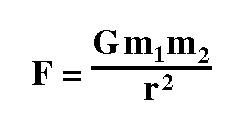Gravitational Force
Geophysical interpretations from gravity surveys are based on the mutual attraction experienced between two masses* as first expressed by Isaac Newton in his classic work Philosophiae naturalis principa mathematica (The mathematical principles of natural philosophy).
Newton's law of gravitation states that the mutual attractive force between two point masses**, m1 and m2, is proportional to one over the square of the distance between them. The constant of proportionality is usually specified as G, the gravitational constant. Thus, we usually see the law of gravitation written as shown to the right where F is the force of attraction, G is the gravitational constant, and r is the distance between the two masses, m1 and m2.

*As described on the next page, mass is formally defined as the proportionality constant relating the
force applied to a body and the accleration the body undergoes as given by Newton's second law,
usually written as F=ma. Therefore, mass is given as m=F/a and has the units of force over
acceleration.
**A point mass specifies a body that has very small physical dimensions. That is, the mass can be
considered to be concentrated at a single point.
Gravity
- Overviewpg 12
- -Temporal Based Variations-
- Instrument Driftpg 13
- Tidespg 14
- A Correction Strategy for Instrument Drift and Tidespg 15
- Tidal and Drift Corrections: A Field Procedurepg 16
- Tidal and Drift Corrections: Data Reductionpg 17
- -Spatial Based Variations-
- Latitude Dependent Changes in Gravitational Accelerationpg 18
- Correcting for Latitude Dependent Changespg 19
- Vari. in Gravitational Acceleration Due to Changes in Elevationpg 20
- Accounting for Elevation Vari.: The Free-Air Correctionpg 21
- Variations in Gravity Due to Excess Masspg 22
- Correcting for Excess Mass: The Bouguer Slab Correctionpg 23
- Vari. in Gravity Due to Nearby Topographypg 24
- Terrain Correctionspg 25
- Summary of Gravity Typespg 26
